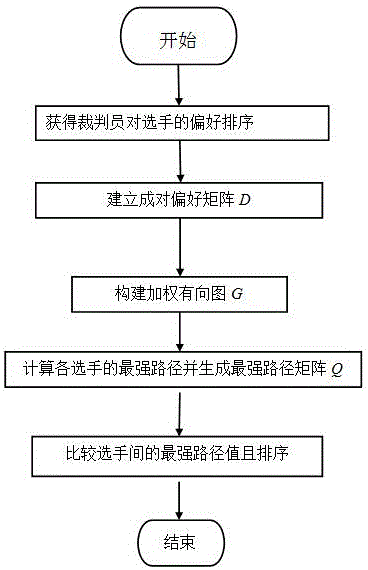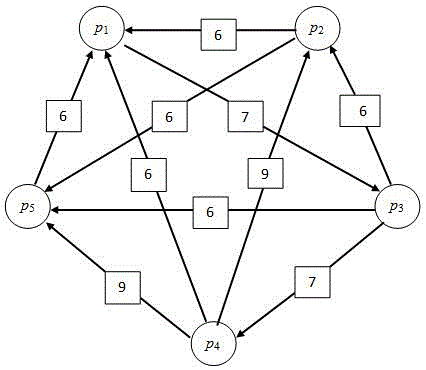Competition score evaluation method based on social selection theory
A theory and performance technology, applied in the field of competition evaluation and group decision-making, which can solve problems such as the lack of objectivity of competition results
- Summary
- Abstract
- Description
- Claims
- Application Information
AI Technical Summary
Problems solved by technology
Method used
Image
Examples
Embodiment 1
[0040] Example 1: Such as Figure 1-2 As shown, a competition performance evaluation method based on the theory of social choice, first obtains the referee's preference relationship with the players, and builds the paired preference matrix of the players; then constructs a directed graph according to the paired preference matrix, and calculates The strongest path: Finally, the strongest path matrix is generated, and the final ranking of the players is obtained by comparing the strongest paths between the players.
[0041] The specific steps of the method are as follows:
[0042] Step1. Obtain the referee's preference relationship with the players;
[0043] Suppose the referees gather as R ={ r 1 , r 2 ,..., r m }, the player set is P ={ p 1 , p 2 ,..., p n }, create referee r i A R ( i =1,2,..., m ) To the players p x , p y A P ( x , y =1,2,…, n ) Preference relationship s i ( p x , p y ):
[0044] ① p x ≻ i p y Referee r i Think player p x Better than p y ;
[0045] ② p x ≺...
Embodiment 2
[0063] Example 2: Such as Figure 1-2 As shown, a competition performance evaluation method based on the theory of social choice, first obtains the referee's preference relationship with the players, and builds the paired preference matrix of the players; then constructs a directed graph according to the paired preference matrix, and calculates The strongest path: Finally, the strongest path matrix is generated, and the final ranking of the players is obtained by comparing the strongest paths between the players.
Embodiment 3
[0064] Example 3: Such as Figure 1-2 As shown, a competition performance evaluation method based on social choice theory, the specific implementation steps are as follows:
[0065] 1) Obtain the referee's preference for players;
[0066] In a competition with 10 referees and 5 players, the referees’ preferences for players are as follows:
[0067] 4 referees think p 1 ≻ p 3 ≻ p 4 ≻ p 2 ≻ p 5 ;
[0068] 2 referees think p 3 ≻ p 4 ≻ p 2 ≻ p 5 ≻ p 1 ;
[0069] 3 referees think p 4 ≻ p 5 ≻ p 2 ≻ p 1 ≻ p 3 ;
[0070] 1 referee thinks p 5 ≻ p 2 ≻ p 3 ≻ p 4 ≻ p 1 ;
[0071] 2) Convert the referee's preference relationship to the players into a paired preference matrix through calculation D =[d( p x , p y )] 5×5 , D( p x , p y ) Indicates that the player p x Better than players p y The number of referees. For example, think players p 1 Better than players p 2 There are a total of 4 judges who think that the players p 2 Better than players p 1 There are 6 judges, so d( p 1 , p 2 )=4, d( p 2 , p...
PUM
 Login to View More
Login to View More Abstract
Description
Claims
Application Information
 Login to View More
Login to View More - R&D
- Intellectual Property
- Life Sciences
- Materials
- Tech Scout
- Unparalleled Data Quality
- Higher Quality Content
- 60% Fewer Hallucinations
Browse by: Latest US Patents, China's latest patents, Technical Efficacy Thesaurus, Application Domain, Technology Topic, Popular Technical Reports.
© 2025 PatSnap. All rights reserved.Legal|Privacy policy|Modern Slavery Act Transparency Statement|Sitemap|About US| Contact US: help@patsnap.com


